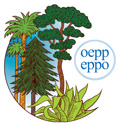
First record of the onion psyllid Bactericera tremblayi (Wagner, 1961) (Insecta: Hemiptera: Sternorrhyncha: Psylloidea) and new symptoms on leek crops in France
David Ouvrard (June 2012) – Department of Life Sciences, The Natural History Museum, Cromwell Road, London SW7 5BD, UK
Originally described by Wagner (1961) from Italy in the genus Trioza, the jumping plant louse Bactericera tremblayi (figures 1–3) has been found infesting leek (Allium porrum) crops in the French department of Ain (center east of France) in 2000 when a large part of the produced vegetable was damaged and unsaleable. Since then, the triozid populations varied considerably in size, with peaks in 2000 (destruction of a quarter of the crops), 2004 (ca. 15 ha out of 300) and 2011 (ca. 35 ha out of 300) in this department. The insect was also found in the departments Haute-Garonne, Landes, Maine-et-Loire, Val d’Oise and Yvelines (JD. Ferrier, pers. comm.), covering large areas of continental France. Each time, unknown symptoms were observed on leek. The presence of these symptoms in some other departments (like Tarn-et-Garonne) has to be confirmed, but it is a fact that B. tremblayi is already largely distributed in France.

Figure 1: Eggs of Bactericera tremblayi on leek leaves

Figure 3: Adult female laying eggs on leek leaves


Figure 2: 1st (top) and 2nd (bottom) instar larva on leek leaves
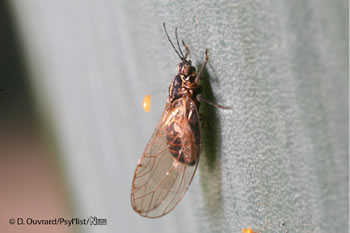
Until now, B. tremblayi was reported from France only by Mifsud et al. (2010), but without any reliable source. Indeed, the species is reported formally from Italy (Wagner, 1961; Tremblay, 1965; Conci and Tamanini, 1988), Turkey (Klimaszewski and Lodos, 1979), Switzerland (Burckhardt, 1983; may be erroneous, D. Burckhardt, pers. comm.), Greece (Burckhardt, 1988), Iran (Burckhardt and Lauterer, 1993; Kazemi and Jafarloo, 2008) and Serbia (Jerinić-Prodanović, 2006). The record from Syria by Klimaszewski (1968) remains doubtful. All published records are detailed in the Psyl’list database (Ouvrard, 2012).
B. tremblayi belongs to a group of three species, in which it is morphologically closer to B. nigricornis (Foerster, 1848) than to B. trigonica Hodkinson, 1981. This “Bactericera nigricornis Foerster group” is composed of multivoltine species (Hodkinson, 2009), feeding on a variety of herbaceous plants (Burckhardt and Lauterer, 1997), and overwintering as adults (Lauterer, 1991). Among their host-plants, some are cultivated like beet, cabbage, carrot, onion, parsley or potato. As mentioned by Hodkinson (1981), some confusion occurred in the past, as well as misidentifications (Jerinić-Prodanović, 2006), but the revision of the group by Hodkinson (1981), and the synonymy between B. nigricornis and B. brassicae (Vasil'ev, 1922) by Burckhardt and Lauterer (1997) have clarified the systematics. The paramere shape (figures 5–6) is diagnostic and allows to separate males of the three species. To a lesser extent (due to intraspecific variation), the shape of the genal processes (figure 4) can be used for discriminating B. tremblayi from B. nigricornis and B. trigonica. Unfortunately, many slide preparations from the collections show various orientations of the parameres, which can lead to false identifications. In that case, the length of the apical segment of the aedaeagus as well as the shape of its apex are useful to distinguish B. nigricornis from B. trigonica (Figure 7). However, the females of the group are similar and a large sampling may be necessary to ensure the presence of males, especially during the early period of oviposition after winter when females are by far predominant. All larval stages are dorso-ventrally compressed, of orange or light brown colour (figure 2). The first instars are more elongated than the discoid last stages, but all are surrounded by typical triozid fringe of sectasetae, bearing wax filaments of various length. The orange elongated eggs bear a long pedicel (figure 1).
Figure 4: Head
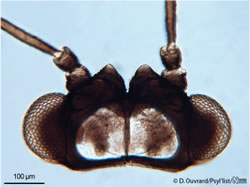
Bactericera nigricornis
Figure 5: Male genitalia, lateral view, left
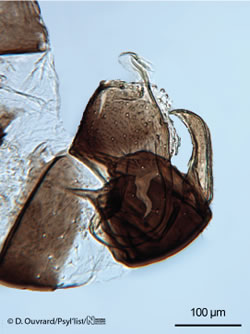
Bactericera nigricornis
Figure 6: Parameres, lateral view, left
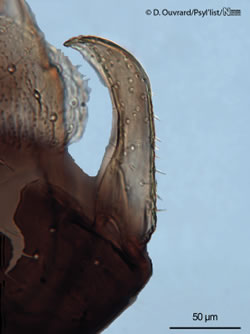
Bactericera nigricornis
Figure 7: Apex of aedeagus
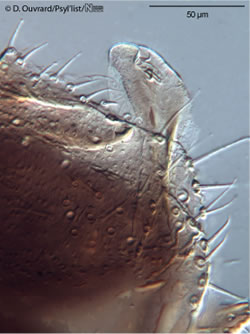
Bactericera nigricornis
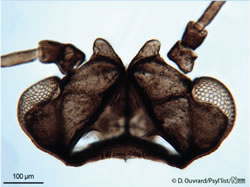
Bactericera tremblayi
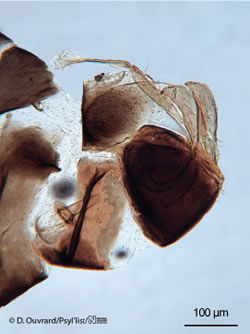
Bactericera tremblayi
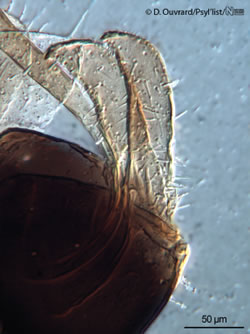
Bactericera tremblayi
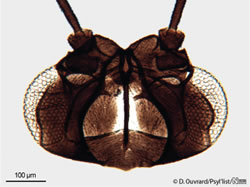
Bactericera trigonica
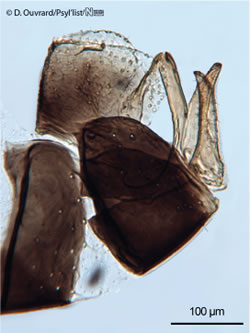
Bactericera trigonica
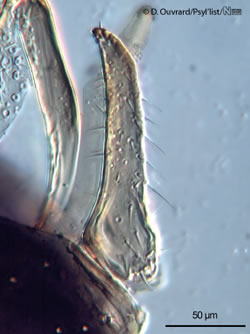
Bactericera trigonica
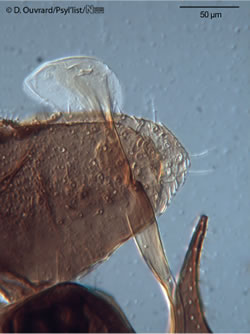
Bactericera trigonica
Until now, B. tremblayi has been reported as a pest almost exclusively on onion (Kazemi and Jafarloo, 2008), Jerinić-Prodanović (2006) reporting explicitely no damage on leek in a large survey undertaken in Serbia between 1994 and 1998. This newly discovered high populations of B. tremblayi on leek in several regions of France far away from each other is associated with the observation of new symptoms on the crop. The new symptoms are longitudinal yellow stripes on the cylinder (whole cylinder becoming yellow in last stages, starting from green leaves down towards the roots). The bundled leaf sheaths may burst, and some roots can grow up between the burst sheaths. At the same time, the aerial tip of the green leaves withers, the colour changes from bluish green to dark shiny green, and eventually the plant may die (figure 8). The seriousness of these symptoms indicates that B. tremblayi could be the vector of an unknown phytopathogen like the nearctic Potato/Tomato psyllid Bactericera cockerelli (Šulc, 1909) on potato and other Solanaceae (vector of the bacterium Candidatus Liberibacter solanacearum). Further studies involving field monitoring, large entomological surveys and molecular techniques are urgently needed in order to demonstrate the correlation between these symptoms and the jumping plant louse, as well as the exact nature of this interaction (physical role of the sap-sucking insect on the weakness of the plant and/or transmission of a microbial pathogen).
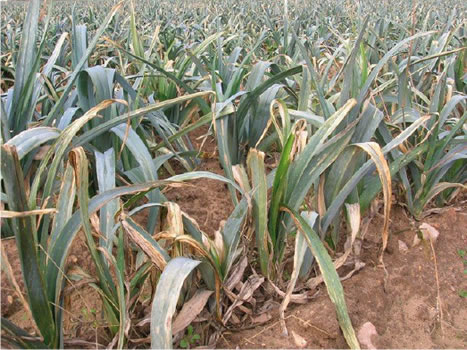
Figure 8: Symptoms on leek infested by B. tremblayi in the field
Photos: JD Ferrier, Chambre d'Agriculture de l'Ain (FR)
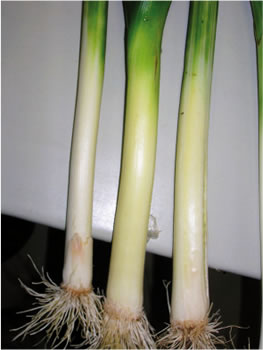
Acknowledgements
I warmly thank Mr. Jean-Daniel Ferrier, Chambre d’agriculture de l’Ain, for alerting me on the presence of the psyllid on leek, as well as Mr. Laurent Fauvre, MNHN-Paris, for the pictures of the eggs and the larvae. Many thanks also to Dr. Daniel Burckhardt, Naturhistorisches Museum, Basel, Switzerland, for his useful comments on this text, and to Dr. Andrew Polaszek, NHM-London for his help with the pictures of slides.
References
Burckhardt D (1983) Beiträge zur Systematik und Faunistik der schweizerischen Psylloidea (Sternorrhyncha). Entomologica Basiliensia 8, 43-83.
Burckhardt D (1988) The jumping plant lice or psyllids (Homoptea: Psylloidea) from Greece. Biologia Gallo-hellenica 13, 107-110.
Burckhardt D & Lauterer P (1993) The jumping plant-lice of Iran (Homoptera, Psylloidea). Revue Suisse de Zoologie 100(4), 829-898.
Burckhardt D & Lauterer P (1997) A taxonomic reassessment of the triozid genus Bactericera (Hemiptera: Psylloidea). Journal of Natural History 31(1), 99-153.
Conci C & Tamanini L (1988) The genus Bactericera in Italy (Homoptera: Psylloidea). Studi Trentini di Scienze Naturali, Acta Biologica 64(1987), 165-181.
Hodkinson ID (1981) Status and taxonomy of the Trioza (Bactericera) nigricornis Forster complex (Hemiptera: Triozidae). Bulletin of Entomological Research 71(4), 671-679.
Hodkinson ID (2009) Life cycle variation and adaptation in jumping plant lice (Insecta: Hemiptera: Psylloidea): a global synthesis. Journal of Natural History 43(1), 65 - 179.
Jerinić-Prodanović D (2006) Rasprostranjenost, biologija i štetnost, lisne buve Bactericera tremblayi Wagner (Homoptera, Triozidae) u Srbiji [Distribution, Biology and Harmfulnes of Jumping Plant-Louse Bactericera tremblayi Wagner (Homoptera, Triozidae) in Serbia]. Pesticides and Phytomedicine 21(1), 31-38.
Kazemi MH. & Jafarloo MM (2008) Laboratory investigation of the biology of Bactericera tremblayi Wag. (Homoptera: Triozidae) a new pest in onion fields of Iran. American Journal of Agricultural and Biological Sciences 3(4), 686-688.
Klimaszewski SM (1968) Psyllidologische Notizen, XV-XVI. Polskie Pismo Entomologiczne 38(4), 781-790.
Klimaszewski SM & Lodos N (1979) Further data about jumping plant lice of Turkey (Homoptera, Psylloidea). Turkiye Bitki Koruma Dergisi 3(1), 3-16.
Lauterer P (1991) Psyllids (Homoptera, Psylloidea) of the limestone cliff zone of the Pavlovské vrchy Hills (Czechoslovakia). Acta musei Moraviae (Scientiae naturales) 76: 241-263.
Mifsud D, Cocquempot C, Mühlethaler R, Wilson M & Streito J-C (2010) Other Hemiptera Sternorrhyncha (Aleyrodidae, Phylloxeroidea, and Psylloidea) and Hemiptera Auchenorrhyncha. Chapter 9.4. In: Roques A (ed.) Alien terrestrial arthropods of Europe. BioRisk 4(1), 511-552.
Ouvrard D (2012) Psyl'list - The World Psylloidea Database. http://www.hemiptera-databases.com/psyllist - searched on 6 June 2012.
Tremblay E (1965) Studio morfo-biologico sulla Trioza tremblayi Wagner (Hemiptera-Homoptera, Psyllidae). Bollettino del Laboratorio di Entomologia Agraria 'Filippo Silvestri', Portici 23, 37-138.
Wagner W (1961) Trioza tremblayi eine neue Blattfloh-Art aus Italien (Homoptera-Psyllina). Bollettino del laboratorio di Entomologia Agraria 'Filippo Silvestri', Portici 19, 263-269.
